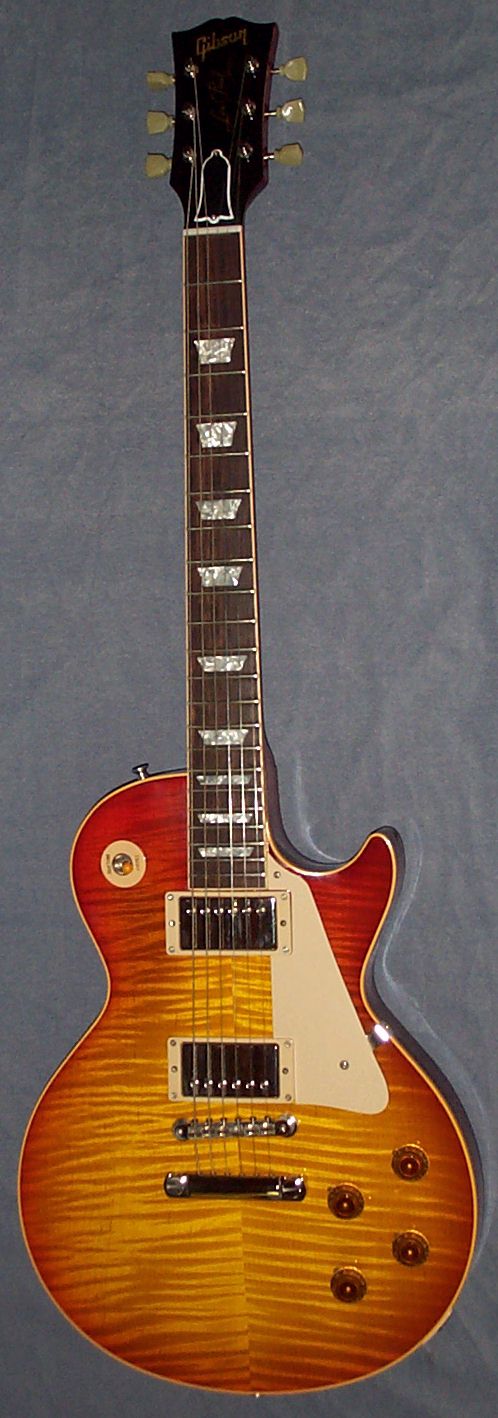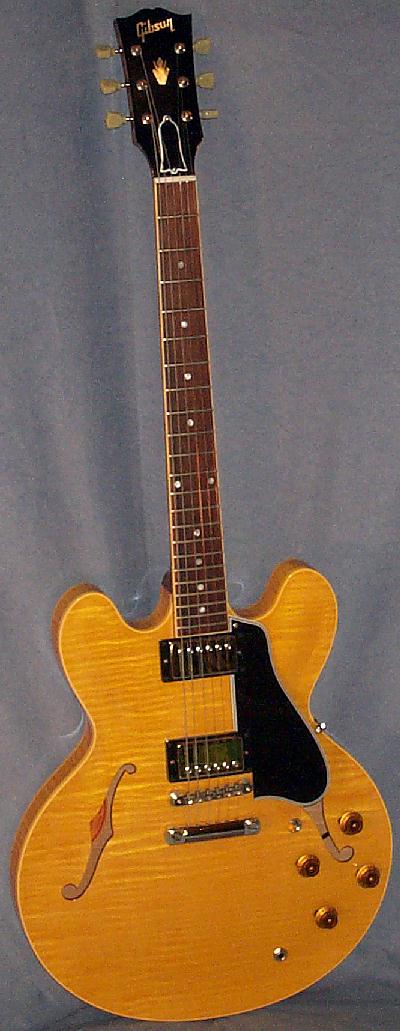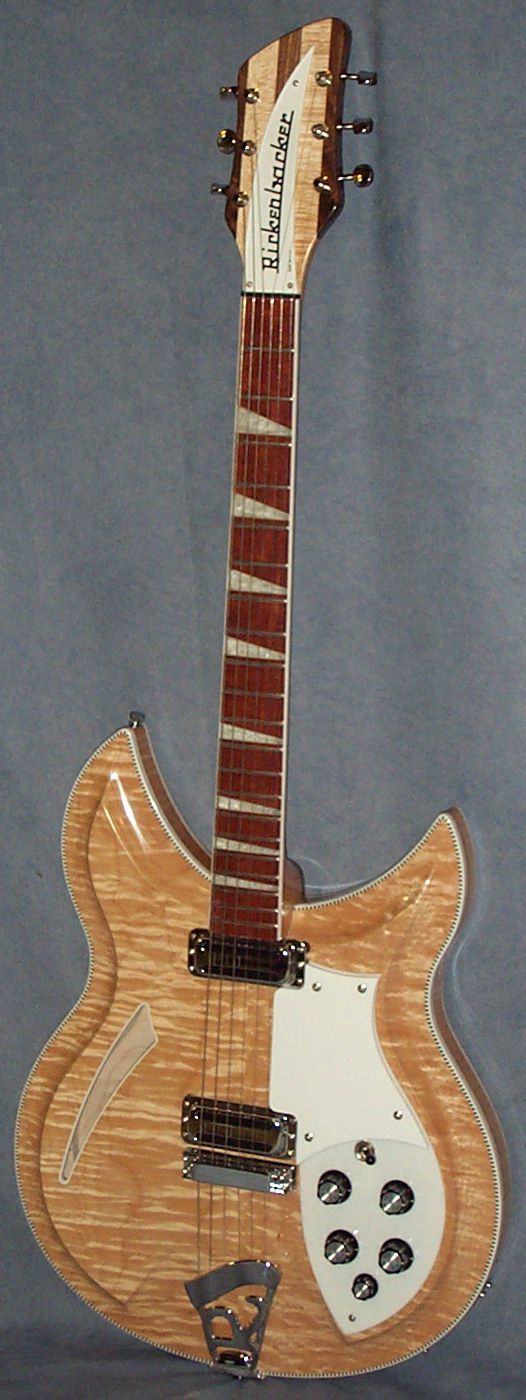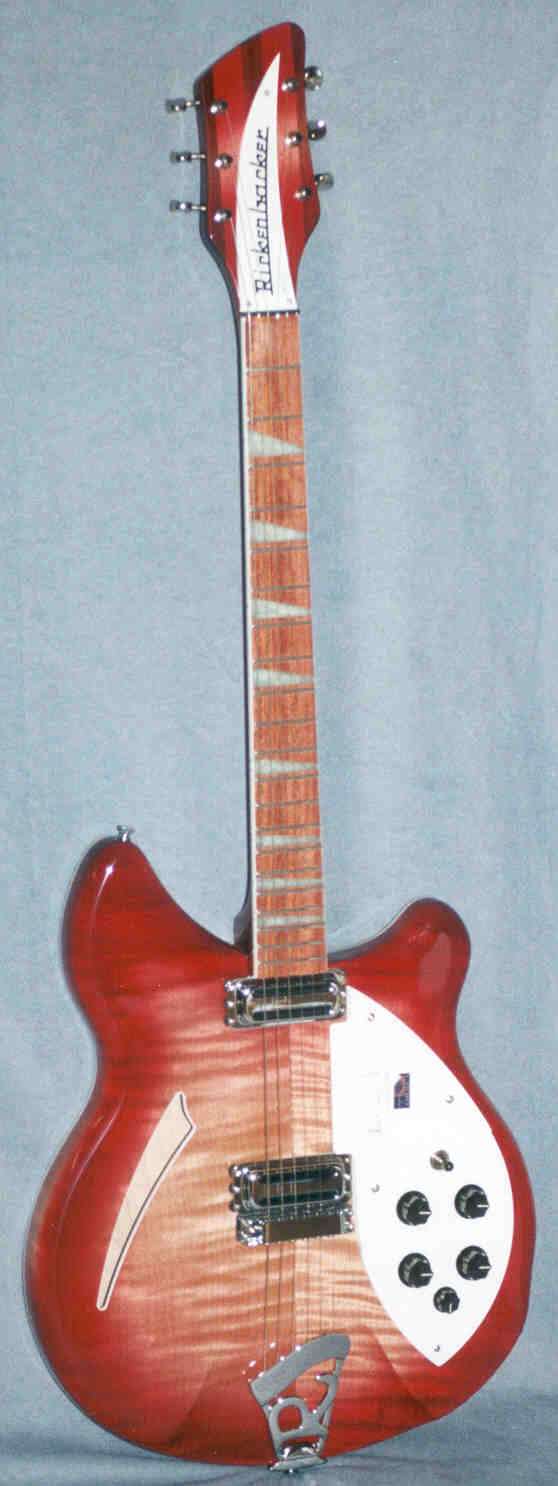Similar Yet
Different
by Greg Gagliano
Copyright 2001, 20th Century Guitar Magazine
I’ve always wondered how electric guitars with similar
construction and identical pickups compare tonally. No better
time than the present to find out! This month’s article will
make an attempt to answer the question: What factor makes the
biggest contribution to the tonal equation, pickups or
construction? I selected the following three pairs of guitars
for analysis: 1999 Gibson ’59 reissue ES-335 and 1999 Gibson
’59 reissue Les Paul, 1991 G&L S-500 Signature and
1990 G&L ASAT III,
and 2000 Rickenbacker 360CW Carl Wilson Signature and 2001 Rickenbacker
381V69. Each pair of guitars utilize the same
pickups. I used
two different amps (4x10 Bassman, Vox AC-30) at a variety of volumes
and
settings. Since TCG’s state-of-the-art, super duper high tech
GBASA
(Guitar and Bass Audio Spectrum Analyzer) unit was unavailable at the
time
of my review, I had to rely on my ears. Editor Acunto was
disqualified
from this review due his known bias for ’59 Les Pauls (including
reissues).
At first glance, a player would expect the Gibson pair to
sound completely different. Sure, they both are loaded with
Gibson’s ’57 Classic PAF reissue pickups, but the Les Paul is a solid
mahogany guitar with maple cap
while the ES-335’s body is semi-hollow, laminated maple. Surprisingly,
the
ES isn't much lighter in weight than the Paul! But they both
have super
chunky 1-piece mahogany necks, tune-a-matic bridges with stop tails,
and
that big honking center block that runs stem to stern on the ES-335
makes it, for all intents and purposes, a solid body guitar,
right? Well, yes and no. While the ES acts like a
solid body guitar in that it
isn’t prone to feedback, it most definitely sounds different than the
Les
Paul.


No matter which amp I used, and no matter what the volume, the results
were the same. There is a very noticeable difference in tone
between the two guitars. Enough of a difference to justify
having both models in your arsenal (I'll write a permission note if you
need one). The ES has less lower midrange, the Paul has a top
end with sting. The scooped
mids work really well for blues (which explains why a lot blues players
like
ES-335s) and the warmer sounding neck pickup has the jazz sound over
the
Paul. The ES has plenty of high end, but it doesn't have the
bite of
the Les Paul. The Les Paul excels at rock which, obviously,
explains why a lot of rock players like LPs. It has more
clarity and has better note separation than the ES. The
Paul’s strong mid-range sent the
Vox into quintessential to-die-for British overdrive. The ES
overdrive
tone through the Vox was a little more loose. The bottom end of the Les
Paul
is more tightly focused which probably contributes to the more
aggressive
tone both clean and overdriven.
The Rickenbackers are much more similar than the Gibsons in
terms of construction. Both are semi-hollow, constructed of
solid, carved maple with a 3-piece
maple-walnut-maple neck replete with rosewood fingerboards, and both
are
fitted with single coil “toaster” pickups. These pickups have
been
recently redesigned to more closely imitate the original “toasters” of
the
mid and late 1960s (scatterwound to 7.4K ohm). Whereas the neck
profiles
of the Gibsons were nearly identical, the Carl Wilson model has a very
slim
oval profile compared to the larger U-shape of the 381V69.
The 360
Carl Wilson is based on Carl’s second style (round top) ’65 Model
360.
It has a thinner top than most 360s making it more resonant and
acoustically
much louder than most semi-hollow Rics. The 381V69 is a
reissue of
the late ‘60s model made most famous by John Kay of Steppenwolf
fame.
The body is deeper than the 360 and utilizes a double “German carve”
top
and back (thank you Roger Rossmeisl!).
Both guitars have that distinctive Rickenbacker tone often
described as “chime” and “jangle”. Yet, played side-by-side,
the 381V69 and 360CW are clearly different. The 360 has more
top end chime and brilliance while the 381 has a much more powerful
midrange and better sustain. The 360 is more of a specialist
and it’s perfect for that Beatley Byrdsy sound. The 381 is
better suited for a wide range of rock and its overdriven tone is more
meaty than the 360. The 360CW did have one trick up its
sleeve that was a complete surprise. Perhaps due to the
thinner top or less pronounced midrange, the neck pickup has absolutely
killer blues tone
rivaling that of a good Stratocaster. The 381, while
completely capable
of being a decent blues guitar and stunningly good looking to boot, was
muddier
and didn’t quite have the sweet singing woman tone of the Carl Wilson
model.
Who’d a thunk it?


Of the guitars tested, the G&Ls are the most similar in terms
of construction. Both have solid ash bodies with bolt-on
maple necks. The S-500 Signature sports a rosewood
fingerboard while the ASAT III makes due with a fretted maple
neck. They both use G&L’s ceramic magnet “Magnetic
Field
Design” pickups. Not surprisingly then, these two guitars
sound remarkably
similar. Not exactly the same, mind you, but similar enough
that difference
are very subtle and practically indistinguishable from each
other.
Both have an organic, woody voice with strong mids and brittle upper
end.
There is a slight difference in attack and sustain that is likely
attributed
to the different tailpieces (hardtail on the ASAT III and vibrato tail
on
the S-500), but all-in-all the guitars sound quite similar.
So what do these comparisons tell us? Basically, the
pickup is nothing more than an amplifier. Sure, it can add
flavor to the tone of the
guitar, but it is not at the heart of the tone. There is an
assumption
here, namely, the pickups are of similar design. Of course, a
humbucker
is going to sound completely different from a Tele bridge
pickup. So,
keep in mind that the primary tone hypothesis assumes you’ll always be
using
an alnico Strat-style pickup in your Strat, etc.
So, our hypothesis is: the primary tone of the
guitar is in its construction.
It can most easily be heard by playing the guitar
acoustically. The
pickup can only amplify the sound the guitar produces. The
same pickup
will “hear” a different sound from a semi-hollow guitar than it will
from
a solid body guitar. Same goes for a laminated maple archtop
versus a solid spruce top archtop, or two semi-hollow guitar of
differing design, or an ash body/maple board Strat versus an alder
body/rosewood board Strat, ad infinitum, you get the picture.
Since the G&Ls are so similar in construction, the primary tone
created by each is nearly the same, hence they sound very
similar. Note too, that hardware is an ingredient
in primary tone and should be considered part of a guitar’s
construction. Case in point – hardtail Strat versus blocked
vibrato tail Strat or ash
tray bridge Tele versus Bigsby-equipped Tele. They don’t
sound the
quite the same.
And primary tone is why it’s difficult to make an electric
guitar that’s a dud (or lemon) sound better simply by swapping
pickups. You might be able to change the flavor of the tone,
but it’s still yucky because the guitar is a dog. As the
saying goes, you can’t make a silk purse out of a sow’s ear… or in
modern American English, you can’t polish a turd. So think
primary tone the next time you play your electric guitars.
It’s the core of your guitar’s sound.
Special thanks to G&List Brad Traweek for the use of
his G&Ls for
this article.
About the author: In addition to pickup
changes, Greg Gagliano has tried alchemy to alter guitar primary
tone. Sadly, neither worked. Mr. Wizard can be
contacted c/o TCG.
Back to GGJaguar's Bibilography
page



